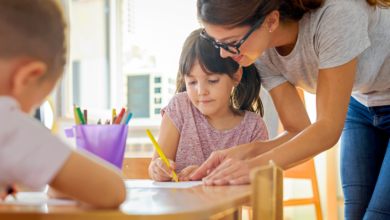Six Questions About How to Talk to Your Child About COVID-19 Answered by Youth Psychology Expert

Six Questions About How to Talk to Your Child About COVID-19 Answered by Youth Psychology Expert
After what feels like a 2-year-long spring break, the back-to-school season is finally here. Historically this is an exciting time for parents and children alike, but this year looks and feels very different. Whether your school district has announced 100% virtual learning, 100% in-person learning with a mask, or a combo; you’re likely feeling many emotions leading up to the first day, and weeks, of school.
So what does your child know and understand about COVID-19 ? And how do you have an age-appropriate conversation without scaring your child.
We spoke with Sara Wilson, PsyD; System Director, Youth Training and Consultation at Burrell Behavior Health in Springfield, Missouri about how to have a discussion with your young children. Here are the answers to the top six questions she receives from parents about how to talk to their children about Coronavirus.
1. What questions do I ask to learn what my child already knows about COVID (without raising concern)?
We all have different levels of knowledge, concern, and questions about COVID-19. A great starting point for conversations with your child is assessing what they may already know. Our encouragement is to not be afraid to talk about the coronavirus. Be direct and gentle and simply ask. Keep your child’s age in mind and let them lead the conversation. You may ask, “What are you hearing about coronavirus?” and, “What questions do you have?” For younger children, you may tailor your language (e.g., “Do you have questions about the new sickness going around?”). Listen with support and attention and find a balance between answering questions (and educating with simple facts) and offering support. This is also an opportunity to let them know there are some rumors and false information floating around about the virus and that you will help them learn the facts about the virus and ways to stay safe. It may also be appropriate to share that this is a virus the world has never seen before, and we keep learning new things about COVID. But, your family can do its best to stay informed and focus on facts.
2. How do you start a conversation with your school-aged child about COVID-19?
Choose a time when your child is likely to want to talk (e.g., dinner table, quiet car ride). Come prepared; educate yourself about COVID-19 from reputable sources (e.g., Centers for Disease Control and Prevention, World Health Organization) so you can provide your child with support and answers (and if you don’t know, that’s okay – let them know you will help them find the answers). Parents are also managing their own questions, fears, and anxiety. Postpone discussion if you’re feeling anxious or overwhelmed (be cautious about increasing fear and anxiety about the virus).
Asking what a child already knows can be a good starting place, and following this up with check-ins can keep the discussion going (e.g., “How are you feeling about the virus?” followed with validating and normalizing that many people are feeling the same way; it’s okay to be upset, worried, angry, confused, sad, etc.). Regular check-ins with your child about COVID-19 can be a great way to open the door for ongoing conversations. The most important part is to be present and open to discussion. Encourage conversations and let your child know they can talk at any time.
3. How do you address concern in an age-appropriate way?
Keeping your child’s age and developmental level in mind will help to guide the type of conversations you have about coronavirus. The goal is to provide ‘just enough’ information and find a balance between oversharing and under sharing (oversharing may place additional burdens on a child and can be alarming, especially if their young minds are not equipped to process that level of information, while under sharing may also leave a child with questions and increased anxiety and apprehension). For kids of all ages, parents can consider a few primary factors: what information to share, how to share (method), and timing of conversations.
Information: Consider what level of information is appropriate for your child, with the ‘just enough’ principle in mind. There are many resources available online that may be helpful. Here are a few examples of children’s book about the virus that may be helpful in answering questions and addressing concerns:
Consider monitoring television and internet use and answer any questions that may come up from your child’s exposure to information about the virus. For older children, you may even consider looking up facts and information with them (from reputable sources).
Method: Be caring, compassionate, and convey as much calm and reassurance as possible. Be attentive and actively listen. Be patient. Work to address concerns and provide reassurance without minimizing your child’s feelings or concerns. Let them know they can keep coming to you with questions or if they are feeling distressed.
Timing: Consider the times when your child is most likely to talk. This could be during family dinner, during a quiet car ride, or during a bedtime routine. If your child does not want to talk initially, that’s okay; be patient and keep trying to open that line of communication. Conversely, if your child asks repeated questions, be patient and be prepared to answer the same question more than once (this may also alert you to the thoughts and concerns your child is focused on and that they may need additional love and support).
4. What are some talking points to include when talking about COVID-19?
Children are likely already aware of the coronavirus, and parents can help children feel informed by sharing fact-based information. Here are a few talking points to include in your conversations about COVID-19:
a. Explain what COVID-19 is (a germ/virus that can make people sick), related symptoms (cough, fever, hard time breathing), and that it affects people differently (some have mild symptoms, though others may need to stay in the hospital for a little while to get better).
b. Talk about how it spreads (typically through respiratory droplets when a person talks, coughs, or sneezes and can also enter the body if the virus is on a person’s hands and they touch their nose, mouth, or eyes).
c. Discuss how it is being handled. Coronavirus is all around the world, and we’ve never seen it before. But, many experts from all over are working very hard to learn more about the virus and are focused on keeping everyone safe.
d. Talk about how your child and family can stay safe.
- Washing hands. Model effective hand washing with your child, and consider having fun with it! Show them how to scrub with soap on all areas of the hands (between fingers, palms, back of hands), and make sure they spend enough time to be completely clean (dance along or sing a song – a popular rule-of-thumb is singing the ‘Happy Birthday’ song twice, or substitute another favorite). Educate about washing hands after coughing, sneezing, when entering a new building or coming home, before meals, or after touching surfaces. Educate about coughing and sneezing into the elbow.
- Social distancing. Explain your family may continue to spend more time at home to slow down the spread of the virus. When your family is out of the house, keeping physical distance is important (at least 6 feet away from others), even if the people we are around don’t seem to be sick. Teach new ways of greeting people (replace high fives and hugs with smiles and waves).
- Masking. Because the virus can spread when a person who has COVID-19 coughs, sneezes, or talks, wearing masks can be a great way to stay safe, especially when outside of the house.
- Staying healthy. This is a great time to focus on healthy habits, like drinking plenty of water, eating nutritious foods, getting physical activity, and getting good sleep. Mental health is an important component of health; emphasize the need for self-care and connection. Maintaining health can build a stronger immune system and have a positive impact on our bodies and lives.
5. What can I do to help my child cope?
Being open, present, and supportive is critical. Providing information, asking questions, and encouraging ongoing dialogue can keep the channels of communication open. Provide reassurance often and let your child know they are safe and cared for. Validate their feelings and help them to focus on a hopeful outlook for the future (e.g., “This is so tough. It’s okay to be scared/worried/frustrated. We are going to get through this together.”). Be loving and supportive with your words and actions (continued and increased physical comfort, like hugs and holding hands, can be great ways to offer support and reassurance).
Manage your own distress and remain as calm as possible. Engaging in your own self-care will not only help you but will help your child as well, as children are looking to adult supports for a reference about how to feel and react. We can also model self-care and healthy ways of coping for our children and send the message that it is important to care for our mental health just like we care for our physical health.
Structure is critical! Keep a regular routine, or establish new routines. Visual schedules can be helpful for displaying daily activities at home. Having structure and a routine and knowing what to expect can go a long way in helping children feel regulated and in control.
Connect with your child. Healing and regulation occur in the context of supportive relationships. Prioritizing quality time, opportunities to play and have fun as a family, and ways to include the family in daily tasks will yield benefits for all (e.g., cooking together, reading together, completing household chores together, spending time outdoors as a family, etc.).
Adapt and be creative. Many of us do not have access to our typical ways of connecting and coping. Take advantage of safe, virtual options to help your child stay connected with family, friends, and groups. Find ways to help your child maintain relationships and avoid isolation while staying safe through the pandemic.
Burrell Behavior Health has created the L.A.U.G.H. acronym, full of great reminders about coping that applies to adults and kids alike!
- Limit exposure to negativity (news, social media, people)
- Anchor (adapt and develop rituals and routines for structure in our days)
- Unite (don’t let physical distance lead to social and emotional isolation)
- Gentle (be gentle with self and others; we are all doing the best we can)
- Health (physical, emotional, social, family)
Lastly, don’t hesitate to reach out for advice and support. If you notice changes in eating, sleeping, daily activity, or are concerned about excessive worry, hopelessness, or behavioral issues, provide support and help your child cope, and consider consulting with mental health providers to see if professional care may be necessary and beneficial.
6. What if someone in our family is exposed or diagnosed with COVID-19?
Keep your child’s age and developmental level in mind when sharing information about a family member exposed to or diagnosed with COVID-19. If the family member is not in the household, you may simply explain that the family member is sick from the virus, and they have to stay away from other people right now so they don’t spread the virus (“They are focusing on getting healthy, and their body is working hard to get better. We can do our part by staying healthy and keeping distance.”). Answer questions and encourage conversation. Provide reassurance and validate feelings (“It’s okay to feel confused/scared/frustrated. We’re in this together, and we will work hard to stay safe and connected.”). Focus on ways to stay connected with the family member (coloring and sending cards, video chatting, and virtual hangouts).
If a family member is exposed or diagnosed with COVID-19 inside the household, this is likely to have a bigger and more direct impact on your child. If the family member is isolated in another part of the house, find ways to stay connected and answer questions. Like mentioned above, let your child know you are staying separated to keep everyone safe and are focused on your family member getting better. Find ways to talk by phone or through the door (play and stay connected by singing, dancing, playing games, and talking, even if at a distance). If the whole family is in quarantine, highlight the bravery of keeping everyone safe and healthy, let them know this is temporary, and find ways to play games, have fun, and stay connected inside.
If a family member is hospitalized, consider how much information is appropriate for your child to know. You can share that most people who are in the hospital with Coronavirus get better (though don’t provide an overly positive outlook if you know the condition to be severe), and doctors and nurses are working hard to help and take care of the family member. Consider checking in with your child and letting them know you will update them with information about how the family member is doing. Let them know that everyone is focused on safety, so you won’t be able to visit (hospitals have germs, and you need to keep your child safe by staying out of the hospital, and you also need to keep your loved one and other patients safe by not bringing any germs into the hospital), but do find ways to stay connected if possible (similar to previous suggestions, talking by phone, video chatting, or drawing pictures and writing cards that can be delivered when safe can help your child feel connected). Consider online resources that may help you address this, like this video by Sesame Street.
To learn more about how Little Sunshine’s Playhouse has increased their safety procedures during COVID-19, view our enhanced safety practices or contact a location near you.





